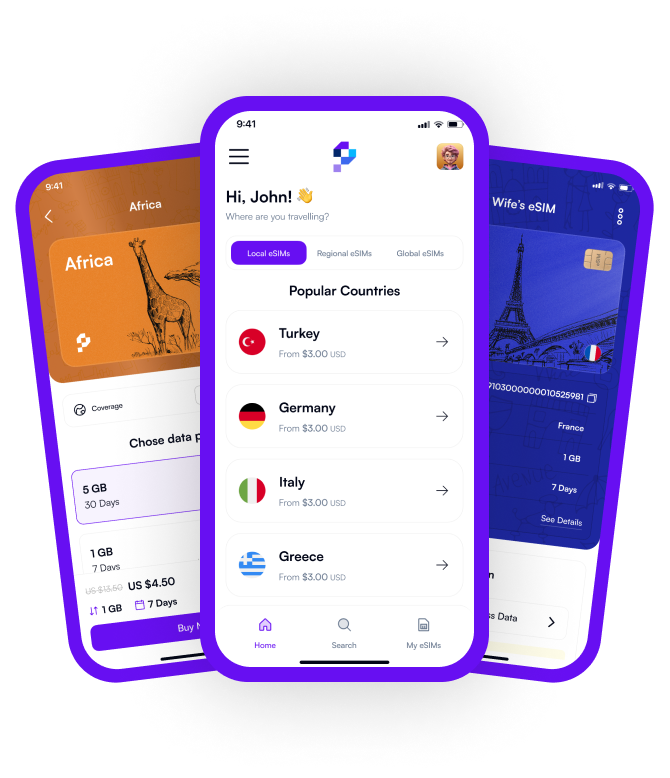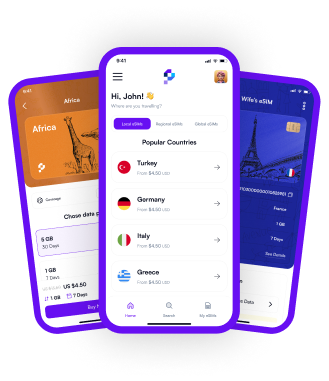Getting an eSIM in Spain is becoming increasingly accessible as more mobile operators offer this technology. The process typically involves a few simple steps. First, ensure that your device supports eSIM functionality, as not all smartphones do. Then, check with your preferred mobile operator in Spain to see if they provide eSIM services. Many major carriers like Movistar, Vodafone, and Orange offer eSIM options for both prepaid and postpaid plans. Once you've confirmed compatibility and availability, you can either visit a physical store or handle the activation process online through the operator's website or mobile app. During activation, you'll receive a QR code or activation code from the operator, which you'll need to scan or enter into your device settings to provision the eSIM.
Alternatively, if you're a tourist or temporary visitor to Spain, you can also obtain an eSIM through various international eSIM providers that offer data plans specifically tailored for travelers. These providers often allow you to purchase and activate an eSIM remotely, either through their website or mobile app, eliminating the need for a physical visit to a local carrier's store. This option is particularly convenient for travelers who want to avoid the hassle of buying a physical SIM card and can provide flexibility in terms of data plans and coverage options. Regardless of whether you're a resident or visitor, obtaining an eSIM in Spain offers a convenient and efficient way to stay connected without the need for a physical SIM card.
Can I Get eSIM in Spain?
Yes, you can get an eSIM in Spain. Several major mobile operators in Spain, such as Movistar, Vodafone, and Orange, offer eSIM services for both residents and visitors. To obtain an eSIM, ensure that your device supports eSIM functionality and then check with your preferred mobile operator to see if they provide eSIM options. You can typically activate an eSIM either by visiting a physical store or handling the process online through the operator's website or mobile app. Additionally, international eSIM providers catering to travelers also offer eSIM options for those visiting Spain, allowing for remote activation without the need for a physical SIM card.
How Do I Setup eSIM in Spain?
Setting up an eSIM in Spain is a straightforward process that typically involves a few simple steps. First, ensure that your device supports eSIM functionality, as not all smartphones do. Once confirmed, you can proceed to acquire an eSIM from your preferred mobile operator in Spain, such as Movistar, Vodafone, or Orange. You can do this by visiting their website, mobile app, or a physical store. If you're a tourist or temporary visitor, you may also opt for international eSIM providers that cater to travelers.
After obtaining the eSIM, the activation process usually involves scanning a QR code or entering an activation code provided by the operator into your device's settings. This can typically be done by navigating to the "Mobile Data" or "Cellular" section in your device settings and selecting the option to add a new plan. Follow the prompts to scan the QR code or enter the activation code, and your eSIM should be provisioned and ready to use. Once activated, you can enjoy the benefits of having a digital SIM card, including the ability to switch between multiple plans without needing to physically swap SIM cards.
Why Should You Use ESIM in Spain?
Using eSIM in Spain offers several advantages that make it an attractive option for both residents and visitors. Firstly, eSIM provides convenience and flexibility, allowing users to easily switch between different mobile operators and plans without needing to physically swap SIM cards. This is particularly beneficial for travelers who may want to access local mobile services without the hassle of purchasing and installing a physical SIM card. Additionally, eSIM eliminates the risk of losing or damaging a traditional SIM card, as it is securely embedded within the device and can be managed digitally.
Moreover, eSIM technology supports multiple profiles on a single device, enabling users to have separate numbers or data plans for personal and business use, all within the same device. This feature is especially useful for individuals who require distinct communication channels for various purposes. Furthermore, eSIM offers environmental benefits by reducing the need for physical SIM cards, which require materials and resources for manufacturing and distribution. Overall, using eSIM in Spain enhances convenience, flexibility, and sustainability, making it a compelling choice for mobile connectivity.
How Much is eSIM in Spain?
The cost of eSIM in Spain can vary depending on the mobile operator and the specific plan you choose. Typically, there may be a one-time fee associated with obtaining the eSIM itself, which can range from being offered for free to a nominal charge. Some mobile operators may waive this fee as part of promotional offers or as an incentive for switching to eSIM technology. Additionally, the cost of eSIM plans in Spain varies depending on factors such as data allowance, call and text allowances, and any additional services or features included in the plan. Users can select from a range of prepaid or postpaid options tailored to their usage needs and budget.
While the initial cost of obtaining an eSIM may be comparable to that of a traditional physical SIM card, eSIM offers long-term benefits that can potentially save users money over time. For example, the flexibility of eSIM allows users to easily switch between different mobile operators or plans, enabling them to take advantage of competitive pricing or promotional offers without incurring additional costs for new SIM cards or activation fees. Furthermore, eSIM technology eliminates the need for physical SIM cards, which can reduce overhead costs for mobile operators and potentially lead to cost savings that may be passed on to consumers in the form of more competitive pricing for eSIM plans.
Does Android Support eSIM in Spain?
Yes, Android smartphones do support eSIM functionality in Spain. Many modern Android devices, including flagship models from manufacturers like Samsung, Google, OnePlus, and others, come equipped with eSIM capabilities. These eSIM-compatible Android devices allow users to take advantage of the benefits offered by eSIM technology, such as the ability to activate multiple mobile plans on a single device without the need for physical SIM cards.
To use eSIM on an Android device in Spain, users typically need to ensure that their device supports eSIM functionality and then proceed to activate the eSIM through their chosen mobile operator. Major mobile operators in Spain, such as Movistar, Vodafone, and Orange, offer eSIM services and support for Android devices. Users can activate an eSIM plan through the operator's website, mobile app, or physical store, and once activated, they can enjoy the flexibility and convenience of managing their mobile connectivity digitally. Overall, Android users in Spain can fully leverage the capabilities of eSIM technology to stay connected seamlessly and efficiently.
Can I use both eSIM and physical SIM in Spain?
Yes, in Spain, it is possible to use both an eSIM and a physical SIM card simultaneously on many smartphones that support dual SIM functionality. Dual SIM smartphones allow users to have two separate phone numbers and data plans active on their device at the same time, offering increased flexibility and convenience. This means that users can take advantage of the benefits of eSIM technology, such as easy activation and management of additional mobile plans, while still retaining the option to use a physical SIM card if desired.


